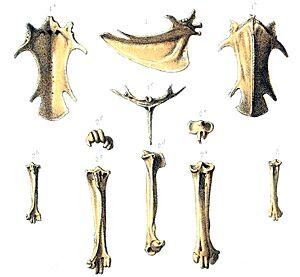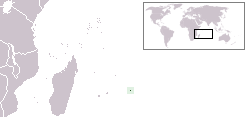Rodrigues pigeon facts for kids
The Rodrigues pigeon or Rodrigues dove (Nesoenas rodericanus) was a type of pigeon that used to live only on the island of Rodrigues. This island is part of the Mascarene islands. Sadly, this bird is now extinct, meaning it no longer exists.
We know about the Rodrigues pigeon from some old bones found by scientists. We also have descriptions from people who saw them alive a long time ago, like François Leguat in 1708 and Julien Tafforet in 1726.
Quick facts for kids Rodrigues pigeon |
|
|---|---|
 |
|
| Subfossil bones, 1873. The bones below (2) where originally assigned to the Malagasy turtle dove | |
| Conservation status | |
| Scientific classification | |
| Genus: |
Nesoenas
|
| Species: |
rodericanus
|
 |
|
| Location of Rodrigues | |
| Synonyms | |
|
Columba rodericana Milne-Edwards, 1873 |
|
Contents
What was the Rodrigues Pigeon like?
The Rodrigues pigeon was about the same size as a tambourine dove. It had feathers that were a dark grey color, like slate.
People who saw these birds said they were very friendly and not afraid of humans. François Leguat wrote that dozens of these pigeons would come to their outdoor table during meals. They would wait for food scraps, and they especially loved melon seeds!
Where did the Rodrigues Pigeon live and nest?
In 1693, these pigeons were seen looking for food on the main island of Rodrigues. However, they only built their nests on smaller islands nearby. This was because rats had been brought to Rodrigues sometime in the 1600s. The rats were a big problem for the birds, so they nested where the rats couldn't reach them.
How did the Rodrigues Pigeon behave?
François Leguat described how tame these birds were:
The pigeons here are somewhat less than ours and all of a slate colour, fat and good. They perch and build their nests upon trees; they are easily taken, being so tame, that we have had fifty about our table to pick up the melon seeds which we threw them, and they lik’d mightily. We took them when we pleas’d, and ty’d little rags to their thighs of several colours, that we might know them again if we let them loose. They never miss’d attending us at our meals, and we call’d them our chickens. They never built their nests in the Isle, but in the little islets that are near it. We suppos’d ‘twas to avoid the persecution of rats, of which there are vast numbers in this Island...
Another person, Julien Tafforet, also wrote about them:
The turtle doves there [Rodrigues] are in great numbers, but on the mainland one sees very few, because they go to feed on the islets to the south, as do the parrots, and come to drink likewise on the mainland [Hume's translation].
This means the birds would fly to the smaller islands to eat and then come back to the main island just to drink water.
Why did the Rodrigues Pigeon become extinct?
The last time anyone recorded seeing the Rodrigues pigeon was in Julien Tafforet's report. Scientists believe the bird likely became extinct around the mid-1700s. This happened when the rats, which had been introduced to the island, finally reached the small islands where the pigeons nested. With their nesting sites no longer safe, the Rodrigues pigeons could not survive.



